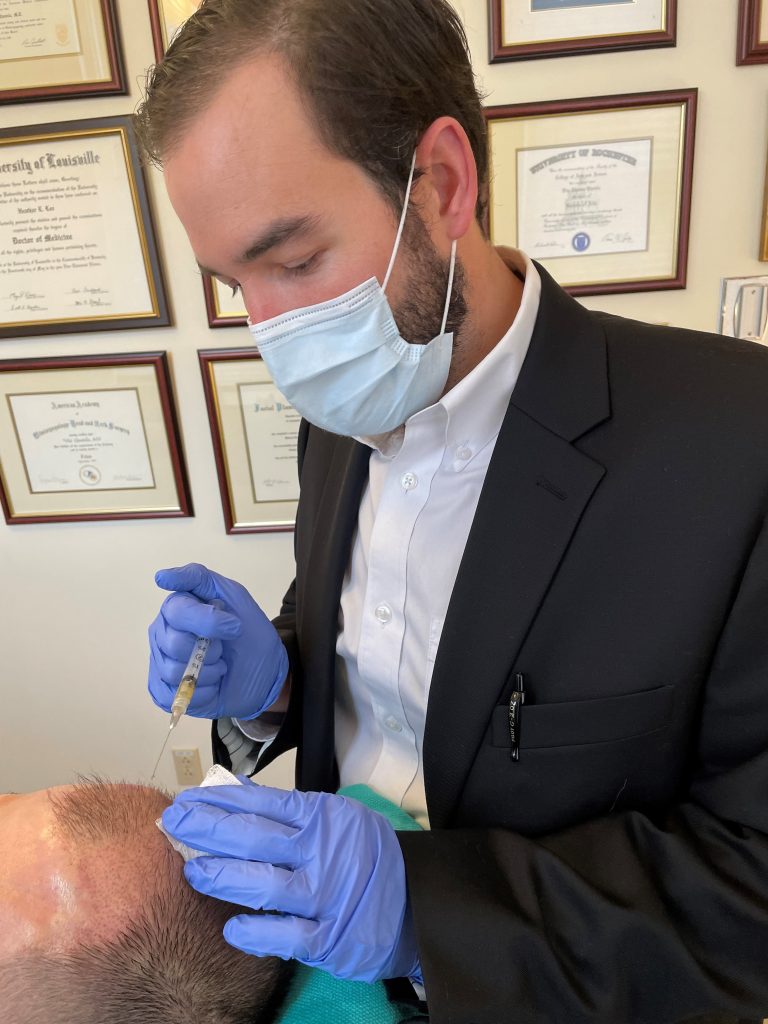-by Alex Montague, MD, double board-certified facial plastic surgeon and hair restoration surgeon
PRP, which is platelet-rich plasma, uses the patient’s own blood that is spun down in a centrifuge to separate out the platelets. It is then injected into the scalp where the PRP, for lack of a better analogy, acts like fertilizer to hair to help it grow fuller and healthier.
We typically place PRP injections into the “minimally-invasive” or “non-surgical” treatment categories, but more frequently we are performing PRP injections at the same time as the definitive “invasive” option, hair transplant surgery.
Why Perform PRP With a Hair Transplant?

But why? Well, in a lot of ways, the reason is pretty simple: we combine PRP with a surgical hair transplant for all the same reasons we do it in a patient who’s not undergoing hair transplant surgery and is using PRP as a stand-alone non-surgical therapy – to enhance hair growth.
But there are some nuanced differences that are worth mentioning. In the case of the patient who is not undergoing a hair transplant, our goal is to essentially halt the balding process in its tracks, shocking follicles that are in their “dying” phase back to life. This will hopefully show a sharp decline in hair loss is experienced in the short term, with an increase in hairs in the long term.
And while all of this holds true about the “native” hairs that are present on the top of the scalp in a patient who is undergoing transplant surgery, the PRP has benefits on newly transplanted hairs as well.
How Does PRP Help Transplanted Hair Grafts?
Hair transplantation, as it stands today, is “robbing Peter to pay Paul.” We aren’t able to replicate hairs (although researchers are working on this, and it will probably be the new frontier in hair restoration in the future). Thus, we are using either the FUE or FUT method to extract hair with its associated follicle from the back of the head (an area genetically predisposed to resist hair loss) and place it in a patient’s area of need.

We are taking it out of its natural environment, and most importantly, its blood supply. All tissue needs blood to survive, and when you pluck a hair follicle off the back of the head, the blood supply doesn’t come with it. So, when the hair gets placed on the top or sides of the head, it has to truly heal in place.
A huge part of that healing process is the re-establishment of a new blood supply to the follicle itself. Many of the growth factors that are present in PRP are vascular growth factors, meaning they help in the formation of new blood vessels, which is exactly what a hair follicle needs when it has been transplanted.
Do You Need PRP to Obtain a Successful Hair Restoration Result?
The survival rate of transplanted hair follicles is very high whether or not PRP is used at the same time, and we have been getting good hair transplantation results for decades without the help of PRP. However, we have certainly been seeing the benefit of the combination of PRP and surgery with our patients in the form of faster healing and faster hair growth after transplant surgery.
Any treatment with hair restoration requires a long time to see results, since it’s waiting on the natural growth process of your real hair. So it is nice to have a tool that helps patients get to the finish line faster. And if it helps save some of the “native” hairs as well, we feel the benefits are well worth it!
For more information about hair restoration, contact our office at 585.244.0323 or online to speak to a Patient Consultant.

Leave a Reply